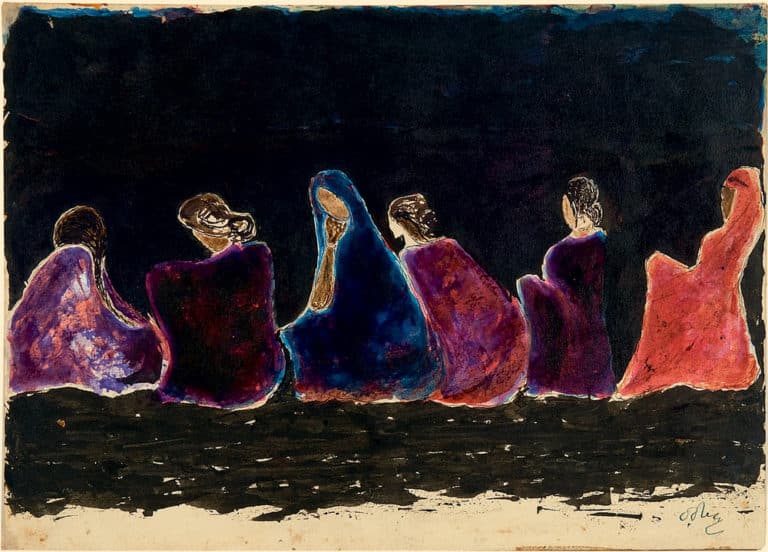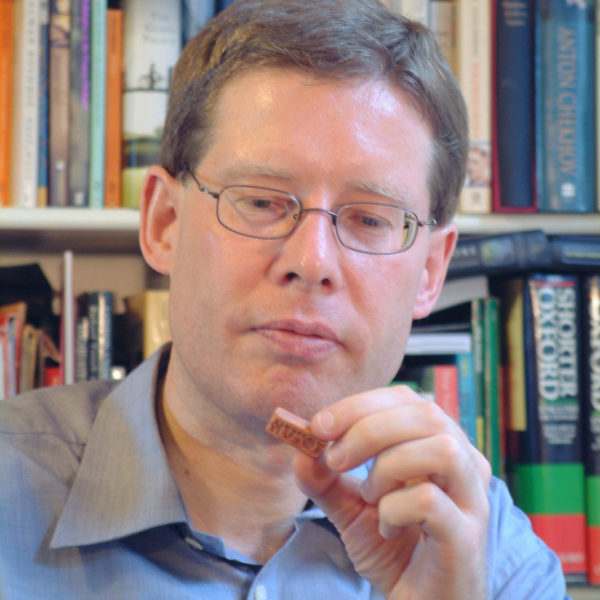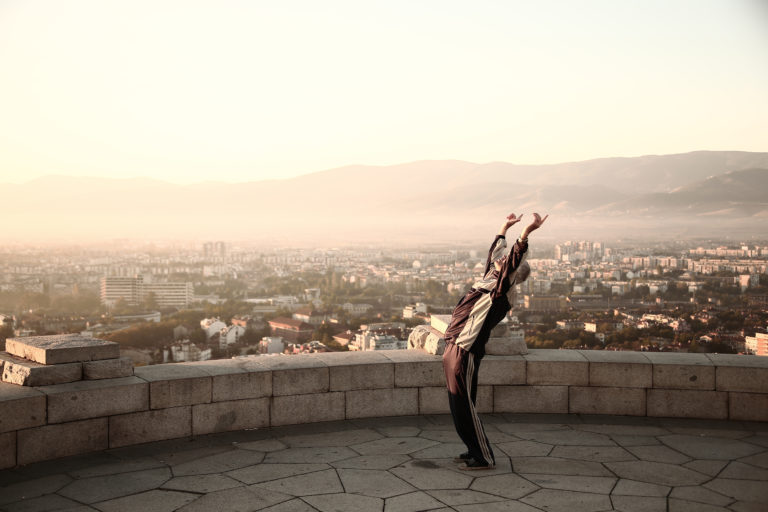
To Paint in the Twilight: The Art of Rabindranath Tagore
“Rabindranath’s paintings and drawings number well over two thousand. Considering the late start, this makes for an astonishing output of great fecundity. It is important to stress that he was uninfluenced by any painter, eastern or western. His work does not stem from any tradition but is truly original. Whether one likes it or not, one has to admit its uniqueness. Personally, I feel it occupies a place of major importance beside his equally formidable output of novels, short stories, plays, essays, letters and songs.”
—Satyajit Ray, film director, graphic artist, and the leading modern interpreter of Rabindranath Tagore
Rabindranath Tagore never had any formal training in art. His sudden eruption into painting in his late sixties, which continued right up to the last year of his life in 1941 when he was 80 years old is, by any standards, remarkable. Indeed, it appears to be without parallel in world art.
As a teenager in Bengal in the 1870s, Rabindranath Tagore doodled with dexterity, and much later, in 1893, did some pencil sketches as part of a Tagore family prank. “Unlike much of his later work some of these [were] brilliant miniatures and a marvel of accurate draughtsmanship,” wrote the Bengali art critic, Kshitis Roy. Tagore himself wrote to his niece around this time that “the Muse of Art” attracted him “but alas, I am past the age when I could woo her.” In 1900 he wrote to his friend, the distinguished scientist Jagadish Chandra Bose:
“It will be some surprise to you to hear that I have been painting in a sketch book. Needless to say, my pictures are not meant for any salon in Paris!”
Another 25 years would pass before his doodles flowered properly, and another 30 years before they were exhibited in a Paris art gallery. During this long gap he saw much of the best of Europe’s art at first hand or in reproduction. He was also probably responsible for requesting the Bauhaus in Germany to send an exhibition of modern art (including works by Paul Klee and Wassily Kandinsky) to Calcutta in 1922.

The calligraphic erasures that form such a distinctive origin of his art began in earnest on the manuscript of his poems entitled Purabi (Easterner), on his way to South America in 1924 with his British friend Leonard Elmhirst, one of the founders of the art colony at Dartington in England. The Argentinian writer Victoria Ocampo, who looked after Tagore in Argentina when he fell ill, was the first person to give him serious encouragement as an artist; later, in Paris, Ocampo organized the first of several Tagore exhibitions in Europe
Elmhirst took an interest in Tagore’s drawing too. Back in Bengal in 1925, Tagore wrote to thank Elmhirst for a new fountain pen that he had sent him from Britain — “to help me with my cult of frenzied drawing … which comes from an excess of dream energy.” Three years later, Tagore told another friend that he was “hopelessly entangled in the spell that the lines have cast all around me … It is the element of unpredictability in art that seems to fascinate me strongly … It is borne on me that this visible world is a vast procession of forms … And strangely enough this has become a source of great joy to me.”
It seems that at first Tagore felt no confidence in his painting. In 1930, shortly before setting out from Bengal for Europe, he wrote to his old friend William Rothenstein, an established artist who was then principal of the Royal College of Art in London, for advice:
“[My pictures] certainly possess psychological interest being products of untutored fingers and untrained mind. I am sure they do not represent what they call Indian Art, and in one sense they may be original, revealing a strangeness born of my utter inexperience and individual limitations.”
His uncertainty never left him, although the praise of European art critics and some artists (including an initially resistant Rothenstein) — and later certain Indian artists — undoubtedly lessened it, giving Tagore what he called “some little faith in my powers as an artist.” He returned to India in 1931, never visited the West again, and painted the bulk of his work.

Tagore’s portraits and landscapes form only part of a bewildering cornucopia of imagery by Tagore, an “innocent universe” (as Ananda Coomaraswamy dubbed it). In the striking words of another Bengali art critic, Prithwish Neogy, Tagore’s art contains:
“…unfurling animated ribbons, composite flower-birds, nameless archaistic beastliness, ambiguous sardonic imps, contorting primitive reptiles, proliferating monster-vessels, oddly sensuous nudes on extravagant furniture, improbable protagonists in a mysterious melodrama, distraught angular pilgrims on an unknown quest eternal, romantic dream houses, illustrations to lost stories, lovers, silhouetted incandescent evening landscapes, murderous enactments, peaceful promenades, familiar types, characters and portraits, masks of sarcasm, masks of terror, sentimental pubescent girls, heads of power and glory, delicate oval moon-faces with silent lips and eyes to transfix, all freshly formed, rampant, iridescent.”
No wonder Tagore told Rothenstein in 1937:
“I have been playing havoc in the complacent and stagnant world of Indian art and my people are puzzled for they do not know what judgement to pronounce upon my pictures. But I must say I am enjoying hugely my role as a painter.”
The best of his works are united by a mysterious immediacy of impact that enchants and then haunts the viewer. Affinities have been found with paintings by Wassily Kandinsky, Paul Klee, Henri Matisse, Amedeo Modigliani, Edvard Munch, Emil Nolde, Pablo Picasso and others, as well as with primitive art — and there is no doubt that Tagore had seen such work and was interested in it — but his own paintings stand alone. They are not of Europe, despite the claims of some critics, both European and Indian, nor are they Indian art from any category known in 1930 or now. European artists of the time were struggling to lose their self-consciousness and abandon accepted academic techniques in the service of truer expression of what they saw and felt by calling on the subconscious and the unconscious. The better Indian artists — for example, Nandalal Bose — were struggling to adapt established western techniques to an Indian setting without compromising their art. Tagore, almost like a child, seems to have cut clean through all this debate; never having had a training, he bypassed known techniques and relied on pure artistic instinct, at least when he started in the late 1920s.
One of his most intriguing works is a series of twelve colored doodles on a beautiful photograph of himself, made in 1934, when Tagore was an old man. In one of the twelve doodles he has transmogrified his bearded face into that of a kind of monster; in another doodle, he has become a woman. No one can look at this series and not comprehend something of Tagore’s mercurial complexity, his “myriad-mindedness.”
The self-portraits are about as far from the saintly, tedious image of Tagore engendered by the many insipid translations of his poetry as one can get. Here, one feels, is a man who recognizes the savage in himself and is grappling with it. Here Tagore is as much Old Bluebeard (as George Bernard Shaw quipped about Tagore) as Wise Man from the East (when Tagore traveled in the West, he was sometimes compared to Jesus Christ in his manner and appearance). Here he hints at some disturbing, and even brutal, emotions in himself—as he does in many of his portraits of others. Yet he never turned his back on humanity and took refuge in abstract art or the natural world. He remained interested in human beings right to the end — like his almost equally polymathic successor in Bengal, Satyajit Ray, whose films (some based on Tagore’s writings) express the gamut of human behavior and emotion, from comedy fantasies intended for children to the darkest hues of tragedy.
Of course, Tagore’s lack of training as an artist is bound to provoke condemnation from some critics, especially if they are skeptical towards the rest of Tagore’s output. In 1986, a well-known British art critic, Brian Sewell, reviewing a London exhibition of Tagore’s art, attacked the works as follows:
“Hash is the word for them. They are abysmal. Never were scribble, scratch, scrawl and blot more industriously used to less effect. He has as much idea of spatial judgement as an infant reaching for the breast; his chromatic freshness is the muddied palette of primary ignorance; and [its so-called] ‘textural subtleties’ is critic’s jargon for ‘this is such a mess I can’t see what’s what’.”
Not everyone will fall for Tagore’s art. But few will deny its originality. Moreover, it is genuinely universal, demanding no knowledge of Bengali culture, unlike Tagore’s writings and songs. In my view, his paintings prove, if proof is still needed, that Tagore can speak to those with no particular interest in the Indian civilization that created him.
All images copyright of Rabindra Bhavana


Share your reflection